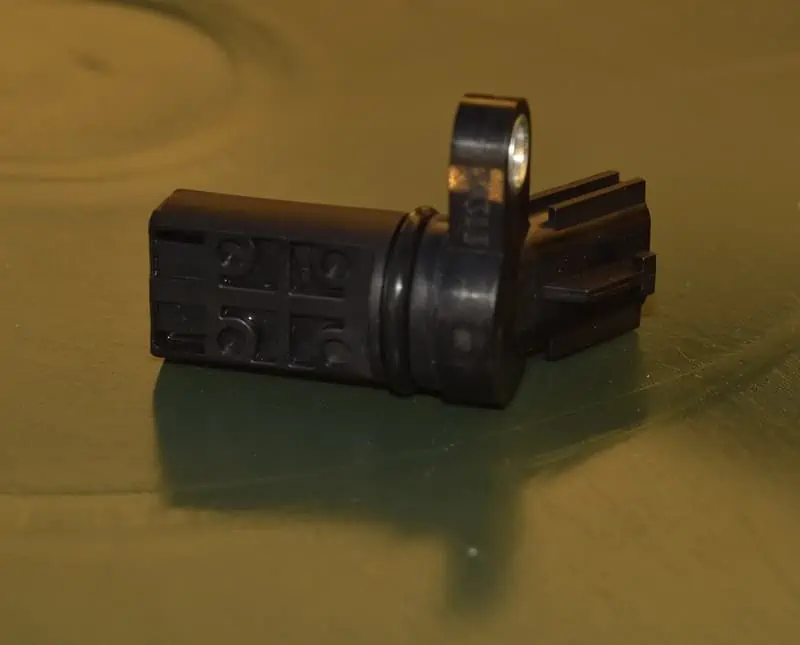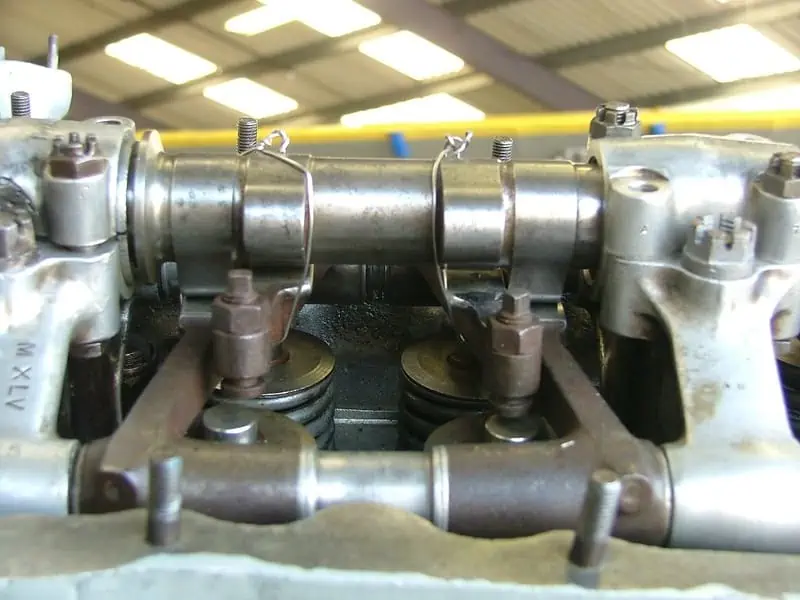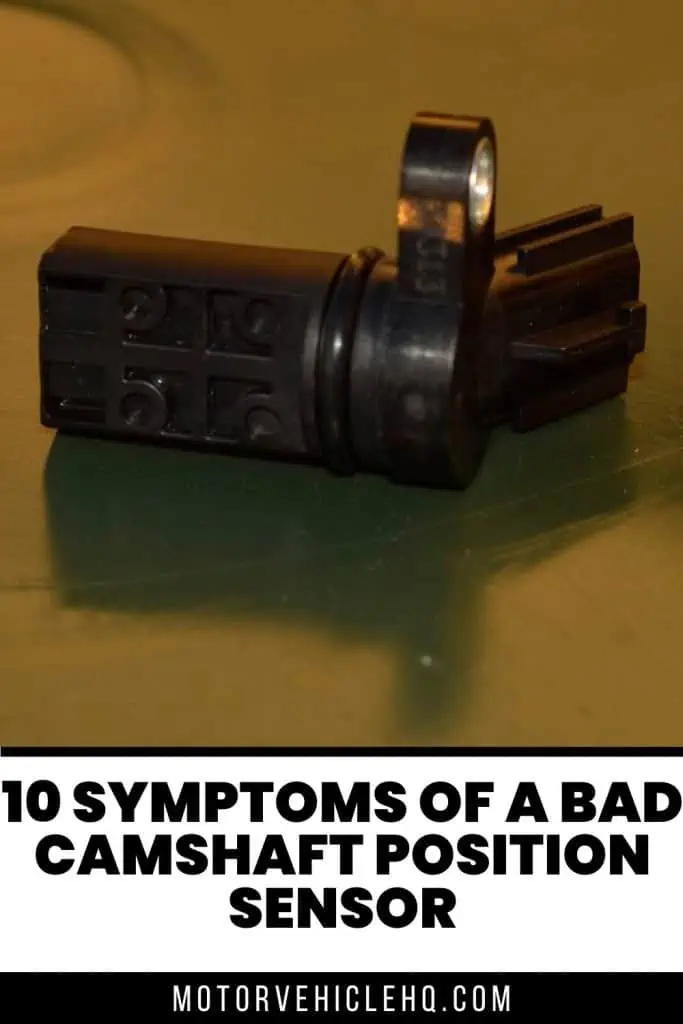A car is made up of several systems working in unison to make hitch-free movement possible day in and day out. These systems are composed of several mechanical and electrical components, and damage to one, can keep your vehicle off the road if overlooked. One such component is the Camshaft Position Sensor.
In this article, we will explore the functions and symptoms of a faulty Camshaft Position Sensor to enable you to accurately diagnose your car with a starter problem.
What is a Camshaft Position (CMP) Sensor?
Camshaft Position Sensor by Teresa Trimm / CC BY-SA 2.0
As the name suggests, a camshaft Position Sensor is a sensor that enables the control engine to determine the exact position of a camshaft. Depending on the design of your engine, the camshaft position sensor could be located on the engine block or the cylinder head. It is also called a phase detector or cylinder identification sensor.
A camshaft is a rotating object usually made of metal that operates the valves of your internal combustion engine.
The camshaft sensor constantly functions when driving your car or when the engine is running. Due to this, it can become defective over time. Aside from oil leaks and cracks causing damage, the ring gear may also wear out and interfere with the readings.
What are the types of CMP sensors?
Camshaft Position Sensors typically consist of three types. These are:
Hall Effect Sensors
This type of sensor has a transistor and some electronics built into the sensor. The sensor requires power supply to function. Because of this, the hall effect sensor has at least three wires.
Magnetic Pick-up Coils
When a magnetic substance (usually a gear tooth) moves past the magnetic field of the magnetic pick-up, voltage is formed. The frequency of this voltage that passes the magnetic field is then measured by the speed control.
Optical Sensors
Optical sensors work on fixing the reception and interruption of the photocell emitted by the source.
Of the three types of sensors, the most common ones used in recent vehicles are the magnetic and Hall Effect Sensors.
The function of the Camshaft Position Sensor
We must understand the core tasks of the Camshaft Position sensor in the daily operation of our vehicle in order to fully comprehend how vital they are. Its functions include:
- The Camshaft Position (CMP) Sensor monitors the relative position of the camshaft to the crankshaft. This is usually done to determine which cylinder is in the power stoke. The data received is then used to modify the spark timing and operation of the fuel injector.
- It is responsible for relaying the position of the camshaft to the Engine Control Module (ECM) as the crank and camshafts are usually in a sequential system.
- The Camshaft Position Sensor uses the data obtained from the camshaft to determine the timing of the ignition and that of the fuel injection. Without these, the engine won’t function properly.
Working Principle of the Camshaft Position Sensor
Camshaft by Les Chatfield / CC BY 2.0
The camshaft sensor (Hall Effect Sensor in this case) works by scanning the ring gear on the camshaft. The constant rotation of this ring gear then changes the Hall Voltage (related to the Hall Principle mentioned above) in the head of the sensor. This voltage change is moved to the Control Unit and assessed to get the required data.
Symptoms of a Bad Camshaft Position Sensor
Your car will not instantly stop working if there is a problem with your Camshaft Position Sensor. However, over time, the overall performance will worsen. Below are the indications to look out for when you want to check if your sensor is no longer functioning as it should. They appear either together or individually.
Presence of the Check Engine Light
The most common sign of a defective Camshaft Position Sensor is the appearance of the check engine light. Since the problem is usually unclear when the check engine light comes on, you should scan for error codes with your OBD2 scanner to be sure or take the car to a mechanic.
The default OBD2 trouble code for a Camshaft Position Sensor is P0340. Car manufacturers have different error codes to help reveal specific issues.
Diagnosing this issue with a professional takes roughly $75, while the cost of an OBD2 scanner is between $25 and $200.
Stalled Engine
An instance where the engine abruptly stops working and your car slowly loses power steering and power braking is a more indicative sign of a faulty Camshaft Position Sensor. Other reasons this happens could be a result of insufficient fuel entering the combustion chamber, electric spark, and so on.
Unfortunately, a stalled engine can happen anytime and anywhere (including when you’re on the Highway). The first thing you’ll want to do when your engine stalls is to keep calm. You should then turn on your hazard light and pull to the shoulder of the road. Restart the engine, shift into gear and slowly drive away (with the hazard lights still turned on).
Ignition Problem
Ignition by Bill Selak / CC BY-ND 2.0
Ignition problems usually go hand in hand with a stalled engine. Because your Camshaft Sensor isn’t working as it should, the engine will have difficulty coming on. However, when it comes on, it can lose power randomly, making your car shake and surge forward unnecessarily.
Other reasons your car is having a hard time coming on include a faulty starter, dead battery, or blocked fuel filter, amongst other things.
Reduced Engine Power
A reduction in the engine power can come in two ways: limp mode, or a situation where the car moves roughly, like vibrations when accelerating (similar to number 3) but does not send any message or show a light on your car’s dashboard.
Limp mode is a feature in cars that automatically activates the moment the Transmission Control Unit notices a fault. Limp Mode turns off less important features like the Air Conditioning and Speakers. Simultaneously, more important features – like your car’s speed – are significantly reduced.
All of these are caused by ineffective combustion and misfires happening in the engine’s cylinders.
Engine Misfire
Engine Misfires happen when the combustion reaction does not work as it should normally. These misfires can occur when you turn on your engine and when it starts idling. When engine misfires happen, they make your engine lose speed. For example, if one of your (four) cylinders misfires, your car engine will experience a 25% loss of power. Although the prices vary, the cost of one new cylinder is a minimum of $500. With the parts and labor cost, it can easily exceed $1,000, almost reaching $2,000.
Rough Idling
Idling is a state of physical rest for your car where the engine is running. Idling occurs in different scenarios. For instance, drivers might have no choice but to ‘idle’ in a traffic jam. Idling also happens when you run your car engine to warm up your battery in cold weather. However, in most situations, idling is unnecessary and harmful to our health and the natural environment because of its accompanying carbon emissions.
Rough idling, on the other hand, occurs when your car’s Revolution Per Minute (RPM) falls below 600 revolutions.
RPM of a healthy car by Josh Miller / CC BY-NC 2.0
The RPM of a healthy vehicle is about 1,000 revolutions. When your car’s RPM is 600 revolutions and lower, it makes your car jumble, making you uncomfortable.
When the Camshaft Position Sensor is faulty, rough idle occurs due to diachronic combustion happening in the cylinders.
Stiff Gear
Certain car models with a defective Camshaft Position Sensor develop a locked transmission that keeps your car stuck in one gear. It gets so severe that the only way to change this gear is to turn off your car engine, wait for a few minutes then turn it on again.
Bad Gas Mileage
Good gas mileage by Nick Nguyen / CC BY-SA 2.0
Because the Camshaft provides flawed information to the Engine Control Unit (ECU), an inappropriate amount of fuel may be let into the Combustion Chamber. If this happens, combustion will also occur at a time not up to the required standard, causing more unburnt fuel and terrible gas mileage. Other than a faulty Camshaft Position Sensor, other causes for poor gas mileage include worn-out piston rings, clogged fuel filters, old engine oil, poor wheel alignment, and so on.
Poor Fuel Economy
As a result of a faulty Camshaft Sensor, the fuel injection timing becomes inaccurate. If this injection takes longer than necessary, excess fuel will be released into the chamber, which will be wasted. On the other hand, if the injection timing happens before the appropriate moment, it causes an insufficient amount of fuel in the chamber. Excessive fuel in the chamber can lead to severe damage like your engine knocking because fumes from your fuel do not compress like air.
Smell of Gas
A faulty camshaft position sensor can cause fuel to build up in your car’s chamber. When this happens, the excessive fuel can make its way out of your exhaust, causing the smell of gas.
How Does a Camshaft Position Sensor Go Bad?
There are many reasons why your car’s Camshaft Position Sensor becomes defective. Some of these reasons include:
- Wear and Tear: Whether you’re driving or not, the moment your car engine is turned on, the Camshaft Position Sensor (CMP) starts monitoring the camshaft speed. The continuous and daily functioning of the sensor leads to Wear and Tear – the end of its service life.
- Accidents: If your car happens to be engaged in an accident, the impact of the collision can damage the sensor, which will stop it from functioning optimally.
Other causes of a defective Camshaft Position Sensor include the damage done by water, internal short circuits, break in the encoder wheel, obstruction in connection with the Control Unit, oil in the engine, and overheating.
Am I Safe if I Drive with a faulty Camshaft Position Sensor?
To a certain degree, yes, you are safe if you decide to drive with a faulty Camshaft Position Sensor. However, the performance of your engine will not be as good as it should, and the fuel consumption of your car’s engine will increase notoriously.
It is advised that you seek the service of a professional and test your Camshaft Position Sensor to avoid extra costs in the future. In many cases, a replacement of the Camshaft sensor is all that is required. If the Camshaft Position Sensor is not repaired before a lot of time passes, it could lead to serious issues within your car’s ignition system, causing the initial repair costs to increase.
Can I replace my car’s Camshaft Position Sensor?
Yes. Replacing your car’s Camshaft Sensor is a relatively easy task. Although it’s best handled by a professional, you can carry out the replacement yourself to save cost.
Replacing a Camshaft Position Sensor takes between one and two hours and the steps involved in doing so vary between car manufacturers. Here are some general tips you can implement:
- Disconnect the wiring of the faulty sensor then unscrew it from the engine.
- Install the new sensor and reconnect the wires.
- Tighten the sensor to avoid leaks.
- Turn on your engine to check for possible errors.
What is the Replacement Cost For a Camshaft Position Sensor?
Camshaft Position Sensor replacement by Teresa Trimm / CC BY-SA 2.0
If it turns out that you decide to leave the replacement to a professional, the average cost will range between $180 and $230, excluding labor costs. With labor costs added, you should expect an additional cost between $73 and $92 added to what you pay for the sensor.
What is the Difference between the Camshaft Position Sensor and Crankshaft Position Sensor?
Crankshaft Position Sensors by ND-Photo.nl / CC BY-NC-ND 2.0
People often mistake the ‘Camshaft Position Sensor’ for the ‘Crankshaft Position Sensor.’ Although they perform similar functions, a Crankshaft Position Sensor gives the engine computer an accurate reading of what angle the crankshaft is at. On the other hand, your Camshaft Position Sensor oversees the speed of rotation and position of the cams and sends the data gotten to the car’s Engine Control Module (ECM) which, in simple words, controls the internal combustion engine of your car to make sure that your car’s engine works on its best potential at all times.
Summary
Although the Camshaft Position Sensor is small in size, it is very important to your car engine. It works hand in hand with the Crankshaft and Engine Control Unit (ECU), and ensures your fuel and air combust in the combustion chamber of your engine at the right time. This is the reason the slightest wear or tear in the camshaft affects your vehicle performance greatly. To prevent this, regular engine maintenance is advised.


Jim Wicks is the founder of MotorVehicleHQ. With over two decades of experience in the automotive industry and a degree in Automotive Technology, Jim is a certified car expert who has worked in various roles ranging from a mechanic, car dealership manager, to a racing car driver. He has owned more than 20 cars over the past 15 years. Ask him about any vehicle you see on the road and he can tell you the make, model and year. He loves the aesthetics of all things cars, and keeps his vehicles in pristine condition.
In his free time, Jim enjoys getting his hands dirty under the hood of a classic car or taking long drives along the country roads. His favorite car? A 1967 Shelby GT500, a true classic that, according to Jim, “represents the pure essence of American muscle.”







